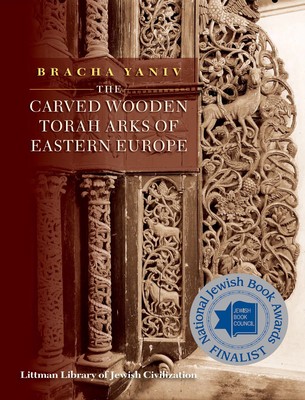
- We will send in 10–14 business days.
- Author: Bracha Yaniv
- Publisher: Littman Library of Jewish Civilization in Association with Liverpool University Press
- ISBN-10: 1906764379
- ISBN-13: 9781906764371
- Format: 21.3 x 27.4 x 2.5 cm, kieti viršeliai
- Language: English
- SAVE -10% with code: EXTRA
Reviews
Description
National Jewish Book Awards Finalist for the Visual Arts Award, 2017.
The carved wooden Torah arks found in eastern Europe from the seventeenth to nineteenth centuries were magnificent structures, unparalleled in their beauty and mystical significance. The work of Jewish artisans, they dominated the synagogues of numerous towns both large and small throughout the former Polish-Lithuanian Commonwealth, inspiring worshippers with their monumental scale and intricate motifs. Virtually none of these superb pieces survived the devastation of the two world wars. Bracha Yaniv's pioneering work therefore breathes new life into a lost genre, making it accessible to scholars and students of Jewish art, Jewish heritage, and religious art more generally. Making use of hundreds of pre-war photographs housed in local archives, she develops a vivid portrait of the history and artistic development of these arks, the scope and depth of her meticulous research successfully compensating for the absence of physical remains. In this way she has succeeded in producing arichly illustrated and comprehensive overview of a classic Jewish religious art form. Professor Yaniv's analysis of the historical context in which these arks emerged includes a broad survey of the traditions that characterized the local workshops of Lithuania, Belarus, and Ukraine. She also provides a detailed analysis of the motifs carved into the Torah arks and explains their mystical significance, among them representations of Temple imagery and messianic themes-and even daring visual metaphors for God. Fourteen arks are discussed in particular detail, with full supporting documentation; appendices relating to the inscriptions on the arks and to the artisans' names will further facilitate future research. This seminal work throws new light on long-forgotten traditions of Jewish craftsmanship and religious understanding.
EXTRA 10 % discount with code: EXTRA
The promotion ends in 22d.17:01:56
The discount code is valid when purchasing from 10 €. Discounts do not stack.
- Author: Bracha Yaniv
- Publisher: Littman Library of Jewish Civilization in Association with Liverpool University Press
- ISBN-10: 1906764379
- ISBN-13: 9781906764371
- Format: 21.3 x 27.4 x 2.5 cm, kieti viršeliai
- Language: English English
National Jewish Book Awards Finalist for the Visual Arts Award, 2017.
The carved wooden Torah arks found in eastern Europe from the seventeenth to nineteenth centuries were magnificent structures, unparalleled in their beauty and mystical significance. The work of Jewish artisans, they dominated the synagogues of numerous towns both large and small throughout the former Polish-Lithuanian Commonwealth, inspiring worshippers with their monumental scale and intricate motifs. Virtually none of these superb pieces survived the devastation of the two world wars. Bracha Yaniv's pioneering work therefore breathes new life into a lost genre, making it accessible to scholars and students of Jewish art, Jewish heritage, and religious art more generally. Making use of hundreds of pre-war photographs housed in local archives, she develops a vivid portrait of the history and artistic development of these arks, the scope and depth of her meticulous research successfully compensating for the absence of physical remains. In this way she has succeeded in producing arichly illustrated and comprehensive overview of a classic Jewish religious art form. Professor Yaniv's analysis of the historical context in which these arks emerged includes a broad survey of the traditions that characterized the local workshops of Lithuania, Belarus, and Ukraine. She also provides a detailed analysis of the motifs carved into the Torah arks and explains their mystical significance, among them representations of Temple imagery and messianic themes-and even daring visual metaphors for God. Fourteen arks are discussed in particular detail, with full supporting documentation; appendices relating to the inscriptions on the arks and to the artisans' names will further facilitate future research. This seminal work throws new light on long-forgotten traditions of Jewish craftsmanship and religious understanding.


Reviews